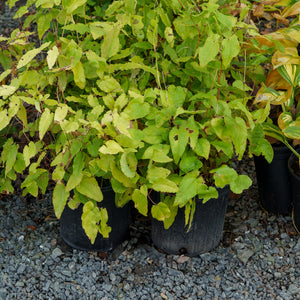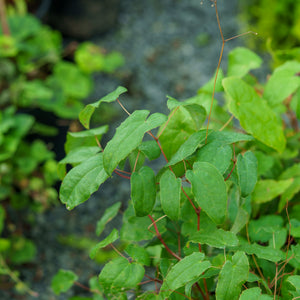The Epimedium Guide
Epimedium, often called barrenwort or bishop’s hat, is an elegant, shade-loving perennial cherished for its delicate, orchid-like flowers and attractive, often evergreen foliage. Native to woodland habitats in Asia and the Mediterranean, epimediums bring understated beauty to shady garden spaces and are especially valued for their resilience, deer resistance, and ability to thrive in dry shade—an environment where few other plants perform well.
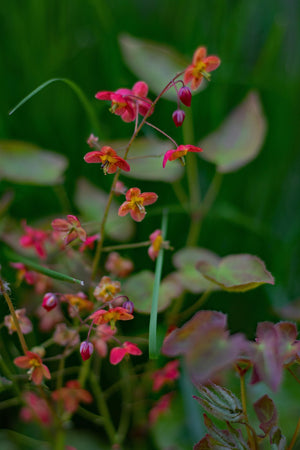
About
Epimedium is a genus of around 60 species in the barberry family (Berberidaceae), with most varieties originating from China. These low-growing perennials form mounds of heart-shaped or arrow-shaped leaves, often flushed with bronze or red in spring and fall. In early to mid-spring, they send up wiry stems bearing delicate, spurred flowers in shades of yellow, white, pink, red, or lavender.
Cultivars range from dainty groundcovers to bold, clumping forms. Noteworthy varieties include the vibrant Epimedium x versicolor 'Sulphureum', a classic with soft yellow blooms and evergreen foliage; 'Amber Queen', prized for its luminous amber-colored flowers and vigor; and 'Domino', with dramatic white and purple bicolor blooms. Other favorites include the romantic 'Pink Champagne', the refined Epimedium lishihchenii, and compact selections like 'Pink Elf' and 'Sweetheart'. Hybrid varieties such as Epimedium × rubrum and Epimedium grandiflorum 'Spring Wedding' offer stunning combinations of color and form.
Epimediums are often overlooked, but their charm, adaptability, and long-term reliability make them indispensable for shaded or woodland gardens.
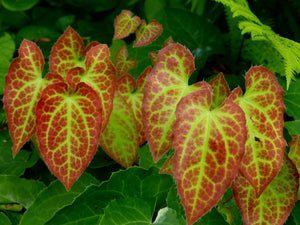
PLANTING
Epimediums establish slowly but are long-lived and dependable once settled. Proper planting will set the stage for years of beauty with minimal maintenance:
- USDA Hardiness Zones: Most varieties are hardy in Zones 5–8, with some species tolerating Zones 4 or 9.
- Soil: Well-drained, humus-rich soil is ideal. Tolerates dry soil once established but appreciates moisture during active growth.
- Sunlight: Prefers part to full shade. Morning sun is acceptable if the soil remains cool and moist.
- Watering: Keep evenly moist during the first growing season. Once established, epimediums are notably drought tolerant.
- Spacing: Space plants 12–18 inches apart to allow for natural spreading.
- Planting Time: Best planted in spring or fall. Mulch to retain soil moisture and suppress weeds.
When planting bare-root divisions, soak them in water for a few hours first and ensure the crown is at or just below the soil line. Water well and mulch lightly.
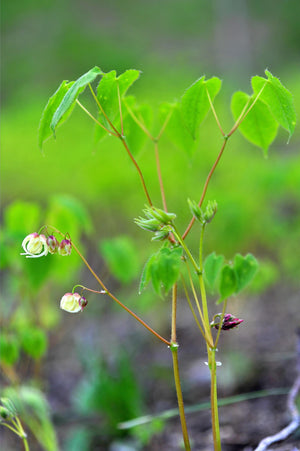
CARE
Epimediums require very little care once established. Their ability to thrive in tough conditions makes them a great choice for low-maintenance landscapes:
- Watering: Provide regular moisture in the first year. Mature plants need minimal water except during extreme drought.
- Fertilizing: Apply a light layer of compost or slow-release fertilizer in early spring.
- Pruning: In late winter or early spring, cut back old foliage to make way for new growth and better display the flowers.
- Dividing: Divide clumps every 4–6 years in spring if they become overcrowded or to propagate new plants.
- Pests & Diseases: Virtually pest- and disease-free. Deer and rabbits typically leave epimedium alone.

HOW TO USE
Epimedium’s refined form and dependable nature make it a go-to plant for shady sites and woodland designs:
- Groundcover: Use to blanket the base of trees or fill in gaps under shrubs.
- Shade Gardens: Mix with ferns, hellebores and hostas for texture and seasonal interest.
- Woodland Borders: Plant in naturalized drifts or along shaded pathways.
- Rock Gardens: Dwarf types like 'Pink Elf' suit crevices and shaded rock gardens.
- Containers: Smaller cultivars adapt well to pots in shaded outdoor settings.
Pair Epimedium with spring ephemerals like trillium or bloodroot, and summer performers like brunnera and astilbe to maintain continuous garden appeal.
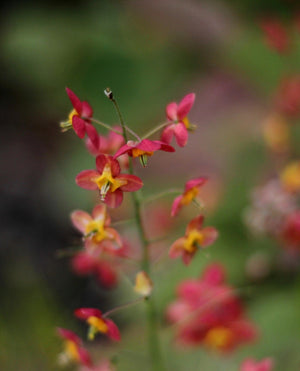
COMMON QUESTIONS
- Do deer eat Epimedium? No, Epimedium is highly deer resistant and often used in areas with heavy deer pressure.
- Does Epimedium spread? Yes, but slowly. It spreads by rhizomes and forms tidy, non-invasive clumps over time.
- How to grow Epimedium? Plant in part to full shade, in moist but well-drained soil. Water regularly during establishment.
- Is Epimedium toxic to dogs? Epimedium is not commonly listed as toxic to dogs, but ingestion should still be avoided.
- Is Epimedium toxic to cats? Similarly, it is not considered highly toxic, but cats should be discouraged from chewing on it.
- How to plant Epimedium? Plant in well-drained soil in a shaded spot, spacing each plant about a foot apart and watering thoroughly.
Conclusion
Epimedium offers a rare combination of beauty, resilience, and adaptability in shady landscapes. Its early-season blooms, evergreen or semi-evergreen foliage, and graceful habit make it a favorite for gardeners seeking structure and subtle color in low-light areas. Whether planted en masse as a groundcover or woven into a mixed woodland border, epimediums quietly enrich the garden with texture, seasonal interest, and long-term reliability.
The Epimedium Collection
Sold Out
Sold Out
Sold Out
Sold Out
Sold Out
Sold Out

